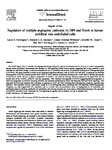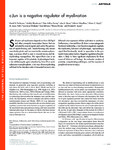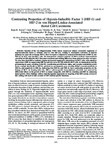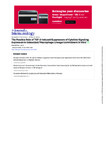Regulation of multiple angiogenic pathways by Dll4 and Notch in human umbilical vein endothelial cells.
| dc.contributor.author | Harrington, LS | en |
| dc.contributor.author | Sainson, RCA | en |
| dc.contributor.author | Williams, CK | en |
| dc.contributor.author | Taylor, JM | en |
| dc.contributor.author | Shi, W | en |
| dc.contributor.author | Li, J-L | en |
| dc.contributor.author | Harris, AL | en |
| dc.date.accessioned | 2017-11-27T15:58:45Z | |
| dc.date.available | 2017-11-27T15:58:45Z | |
| dc.date.issued | 2008-03 | en |
| dc.identifier.issn | 0026-2862 | en |
| dc.identifier.uri | http://hdl.handle.net/10026.1/10301 | |
| dc.description.abstract |
The Notch ligand, Dll4, is essential for angiogenesis during embryonic vascular development and is involved in tumour angiogenesis. Several recent publications demonstrated that blockade of Dll4 signalling inhibits tumour growth, suggesting that it may constitute a good candidate for anti-cancer therapy. In order to understand the role of Dll4 at the cellular level, we performed an analysis of Dll4-regulated genes in HUVECs. The genes identified included several angiogenic signalling pathways, such as VEGF, FGF and HGF. In particular we identified downregulation (VEGFR2, placenta growth factor PlGF) of VEGF pathway components resulting in the overall effect of limiting the response of HUVEC to VEGF. However extensive upregulation of VEGFR1 was observed allowing continued response to its ligand PlGF but the soluble form of the VEGFR1, sVEGFR1 was also upregulated. PlGF enhanced tubulogenesis of HUVEC suggesting that downregulation of PlGF and upregulation of VEGFR1 including sVEGFR1 are important mechanisms by which Dll4 attenuates PlGF and VEGF signalling. Dll4-stimulated HUVECs had impaired ERK activation in response to VEGF and HGF indicating that Dll4 signalling negatively regulates these pathways. Dll4 expression reduced vessel sprout length in a 3D tubulogenesis assay confirming that Dll4 signalling inhibits angiogenesis. Altogether, our data suggest that Dll4 expression acts as a switch from the proliferative phase of angiogenesis to the maturation and stabilisation phase by blocking endothelial cell proliferation and allowing induction of a more mature, differentiated phenotype. The regulation of sVEGFR1 provides a novel mechanism for Dll4 signalling to regulate cells at distance, not just in adjacent cells. | en |
| dc.format.extent | 144 - 154 | en |
| dc.language | eng | en |
| dc.language.iso | eng | en |
| dc.subject | Adaptor Proteins, Signal Transducing | en |
| dc.subject | Basic Helix-Loop-Helix Transcription Factors | en |
| dc.subject | Calcium-Binding Proteins | en |
| dc.subject | Cell Differentiation | en |
| dc.subject | Cell Proliferation | en |
| dc.subject | Cells, Cultured | en |
| dc.subject | Cluster Analysis | en |
| dc.subject | Endothelial Cells | en |
| dc.subject | Enzyme Activation | en |
| dc.subject | Extracellular Signal-Regulated MAP Kinases | en |
| dc.subject | Gene Expression Profiling | en |
| dc.subject | Gene Expression Regulation | en |
| dc.subject | Hepatocyte Growth Factor | en |
| dc.subject | Homeodomain Proteins | en |
| dc.subject | Humans | en |
| dc.subject | Intercellular Signaling Peptides and Proteins | en |
| dc.subject | Membrane Proteins | en |
| dc.subject | Neovascularization, Physiologic | en |
| dc.subject | Oligonucleotide Array Sequence Analysis | en |
| dc.subject | Placenta Growth Factor | en |
| dc.subject | Pregnancy Proteins | en |
| dc.subject | Proto-Oncogene Proteins | en |
| dc.subject | Proto-Oncogene Proteins c-met | en |
| dc.subject | RNA, Messenger | en |
| dc.subject | Receptors, Growth Factor | en |
| dc.subject | Receptors, Notch | en |
| dc.subject | Reproducibility of Results | en |
| dc.subject | Reverse Transcriptase Polymerase Chain Reaction | en |
| dc.subject | STAT1 Transcription Factor | en |
| dc.subject | Serrate-Jagged Proteins | en |
| dc.subject | Signal Transduction | en |
| dc.subject | Snail Family Transcription Factors | en |
| dc.subject | Transcription Factor HES-1 | en |
| dc.subject | Transcription Factors | en |
| dc.subject | Transduction, Genetic | en |
| dc.subject | Vascular Endothelial Growth Factor A | en |
| dc.subject | Vascular Endothelial Growth Factor Receptor-1 | en |
| dc.title | Regulation of multiple angiogenic pathways by Dll4 and Notch in human umbilical vein endothelial cells. | en |
| dc.type | Journal Article | |
| plymouth.author-url | https://www.ncbi.nlm.nih.gov/pubmed/17692341 | en |
| plymouth.issue | 2 | en |
| plymouth.volume | 75 | en |
| plymouth.publication-status | Published | en |
| plymouth.journal | Microvasc Res | en |
| dc.identifier.doi | 10.1016/j.mvr.2007.06.006 | en |
| plymouth.organisational-group | /Plymouth | |
| plymouth.organisational-group | /Plymouth/REF 2021 Researchers by UoA | |
| plymouth.organisational-group | /Plymouth/REF 2021 Researchers by UoA/UoA01 Clinical Medicine | |
| plymouth.organisational-group | /Plymouth/REF 2021 Researchers by UoA/UoA01 Clinical Medicine/UoA01 Clinical Medicine | |
| dc.publisher.place | United States | en |
| dcterms.dateAccepted | 2007-06-15 | en |
| dc.rights.embargoperiod | Not known | en |
| rioxxterms.versionofrecord | 10.1016/j.mvr.2007.06.006 | en |
| rioxxterms.licenseref.uri | http://www.rioxx.net/licenses/all-rights-reserved | en |
| rioxxterms.licenseref.startdate | 2008-03 | en |
| rioxxterms.type | Journal Article/Review | en |





